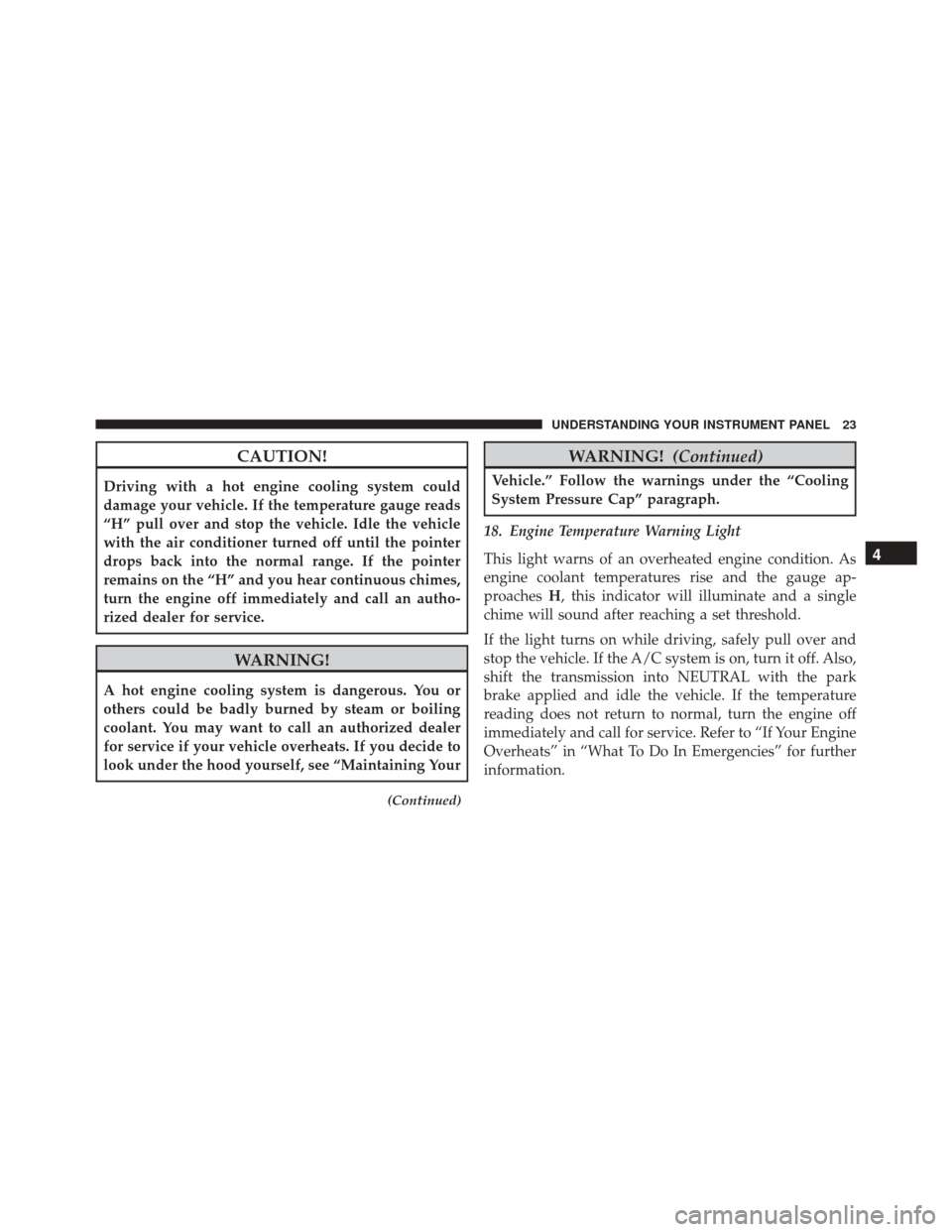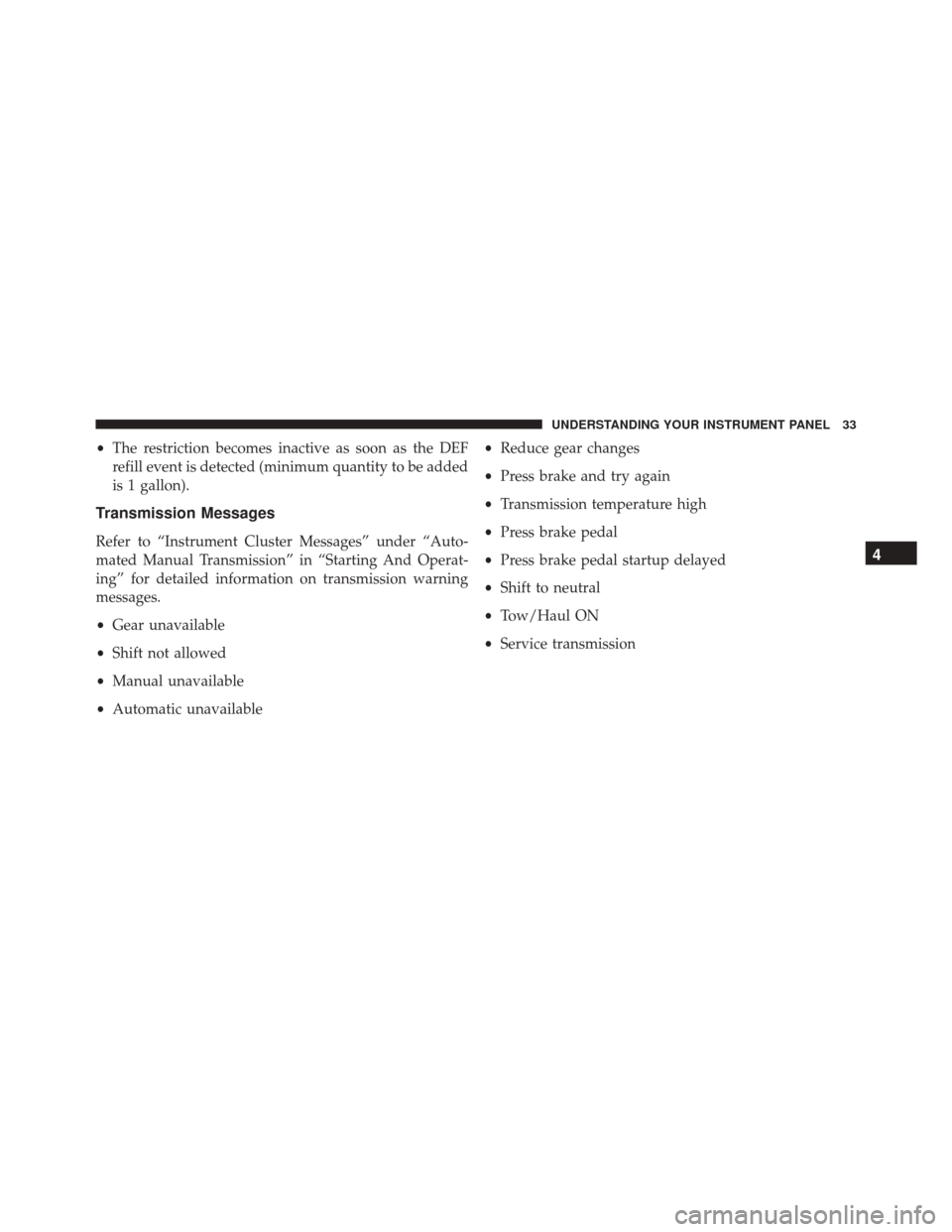2015 Ram ProMaster transmission
[x] Cancel search: transmissionPage 6 of 130

A MESSAGE FROM FCA US LLC
FCA US LLC welcomes you as a turbocharged diesel-
powered vehicle owner. Your diesel vehicle will sound,
feel, drive and operate differently from a gasoline-
powered vehicle. It is important that you read and
understand this manual.
Almost 100% of the heavy trucks in the United States and
Canada are diesel-powered because of the fuel economy,
rugged durability, and high torque which permits pulling
heavy loads.
You may find that some of the starting, operating, and
maintenance procedures are different. However, they are
simple to follow and careful adherence to them will
ensure that you take full advantage of the features of this
engine.NOTE:
•
Some aftermarket products may cause severe engine/
transmission and/or exhaust system damage. Your
vehicle’s powertrain control systems can detect and
store information about vehicle modifications that
increase horsepower and torque output such as
whether or not performance-enhancing powertrain
components, commonly referred to as downloaders,
power boxes, or performance chips have been used.
• Any chassis/suspension or tire size modifications to
the vehicle will effect the performance of the Adaptive
Cruise Control and Forward Collision Warning Sys-
tem.
This information cannot be erased and will stay in the
system’s memory even if the modification is removed.
This information can be retrieved by FCA US LLC, and
service and repair facilities, when servicing your vehicle.
4 INTRODUCTION
Page 10 of 130

ENGINE BREAK-IN RECOMMENDATIONS
The diesel engine does not require a break-in period due
to its construction. Normal operation is allowed, provid-
ing the following recommendations are followed:
•Warm up the engine before placing it under load.
• Do not operate the engine at idle for prolonged
periods.
• Use the appropriate transmission gear to prevent
engine lugging.
• Observe vehicle oil pressure and temperature indica-
tors.
• Check the coolant and oil levels frequently.
• Vary accelerator pedal position at highway speeds
when carrying or towing significant weight. NOTE:
Light duty operation such as light trailer towing
or no load operation will extend the time before the
engine is at full efficiency. Reduced fuel economy and
power may be seen at this time.
The engine oil installed in the engine at the factory is a
high-quality energy conserving type lubricant. Oil
changes should be consistent with anticipated climate
conditions under which vehicle operations will occur.
The recommended viscosity and quality grades are
shown under “Fluids, Lubricants and Genuine Parts”,
under “Maintaining Your Vehicle” in this manual. NON-
DETERGENT OR STRAIGHT MINERAL OILS MUST
NEVER BE USED.
8 THINGS TO KNOW BEFORE STARTING YOUR VEHICLE
Page 12 of 130

SWIVEL SEAT — IF EQUIPPED
The swivel seat lever is located at the lower front inboard
side of the seat. The seat may be turned through 180°
toward the seat on the opposite side and approximately
35° toward the door. The seat may be locked in the
driving position or at the 180° position. To swivel the
seat, pull the swivel seat lever outward, turn the seat to
the desired position and release the lever. The swivel seat
back lever is located at the lower front outboard side of
the seat, to tilt the seat back forward or rearward.
If the vehicle is equipped with interlocking swivel seats,
the seats must be locked in facing forward position while
driving. If the seats are not in the correct position, a
warning will display in the EVIC.
If the driver or the passenger seats are not locked in
facing forward position before the first vehicle move-
ment, the Transmission is forced in Neutral position until
the seats are both locked in facing forward position.When the seats are not in the right position and the first
vehicle movement after the cranking is attempted, a
chime and a text message will appear in EVIC. Rotate
and lock the swivel seats in the correct position before
trying again.
If the driver or the passenger seats are not locked in
facing forward position during the first vehicle move-
ment, a text message will be visualized in the EVIC and
an intermittent chime will sound until key-off or until the
swivel seats are locked in facing forward position. Stop
and move the swivel seats in the correct position before
proceeding.
10 UNDERSTANDING THE FEATURES OF YOUR VEHICLE
Page 20 of 130

7. Odometer/Trip Odometer/Electronic Vehicle Informa-
tion Center (EVIC) Display Area
This display indicates the total distance the vehicle has
been driven.
U.S. Federal regulations require that upon transfer of
vehicle ownership, the seller certify to the purchaser the
correct mileage that the vehicle has been driven. If your
odometer needs to be repaired or serviced, the repair
technician should leave the odometer reading the same
as it was before the repair or service. If s/he cannot do so,
then the odometer must be set at zero, and a sticker must
be placed in the door jamb stating what the mileage was
before the repair or service. It is a good idea for you to
make a record of the odometer reading before the repair/
service, so that you can be sure that it is properly reset, or
that the door jamb sticker is accurate if the odometer
must be reset at zero.Shift Lever Position/Transmission Gear Range
The transmission gear range “R, N, D, 1, 2, 3, 4, 5, 6” is
displayed in the EVIC whenever the engine is running.
With key on/engine off, the display may indicate the
shift lever position rather than the actual transmission
gear position. Refer to “Shift Lever/Transmission Gear
Position” under “Automated Manual Transmission” for
further information.
8. External Light Failure Indicator — If Equipped
The External Light Failure Indicator will come on when a
failure to one of the following lights is detected:
•Side Marker Lights
• Direction Indicators
• Backup Lights
• Parking Lights
• Daytime Running Lamps (DRL)
• Clearance Lights
• License Plate Lights
18 UNDERSTANDING YOUR INSTRUMENT PANEL
Page 21 of 130

The failure relating to these lights could be: one or more
blown bulbs, a blown protection fuse or a break in the
electrical connection.
9. Door Ajar IndicatorThis indicator will illuminate when one or
more door(s) are not fully closed.
10. Glow Plug Light — If Equipped
This vehicle will inhibit engine cranking when the
transmission oil temperature is less than –22° F
(–30° C) and the oil temperature sensor reading indicates an
engine block heater has not been used. The Glow Plug light
will flash during in cold weather for up to 10 seconds. An
externally powered electric engine block heater is available
as optional equipment or from your authorized dealer.
Turning the ignition key to the ON/RUN position illu-
minates the Glow Plug Light, the light will turn off when glow plugs reach the established temperature. You can
start the engine immediately after the light turns off.
A blinking Glow Plug Light (together with a display
message) indicates a failure on glow plugs. Please see
your authorized dealer as soon as possible.
11. Tachometer
The tachometer indicates engine speed in Revolutions
Per Minute (RPM x 1000).
CAUTION!
Do not operate the engine with the tachometer
pointer at high RPM for extended periods. Engine
operation over 3200 RPM can result in significant
damage that will not be covered under the New
Vehicle Limited Warranty.
4
UNDERSTANDING YOUR INSTRUMENT PANEL 19
Page 25 of 130

CAUTION!
Driving with a hot engine cooling system could
damage your vehicle. If the temperature gauge reads
“H” pull over and stop the vehicle. Idle the vehicle
with the air conditioner turned off until the pointer
drops back into the normal range. If the pointer
remains on the “H” and you hear continuous chimes,
turn the engine off immediately and call an autho-
rized dealer for service.
WARNING!
A hot engine cooling system is dangerous. You or
others could be badly burned by steam or boiling
coolant. You may want to call an authorized dealer
for service if your vehicle overheats. If you decide to
look under the hood yourself, see “Maintaining Your
(Continued)
WARNING!(Continued)
Vehicle.” Follow the warnings under the “Cooling
System Pressure Cap” paragraph.
18. Engine Temperature Warning Light
This light warns of an overheated engine condition. As
engine coolant temperatures rise and the gauge ap-
proaches H, this indicator will illuminate and a single
chime will sound after reaching a set threshold.
If the light turns on while driving, safely pull over and
stop the vehicle. If the A/C system is on, turn it off. Also,
shift the transmission into NEUTRAL with the park
brake applied and idle the vehicle. If the temperature
reading does not return to normal, turn the engine off
immediately and call for service. Refer to “If Your Engine
Overheats” in “What To Do In Emergencies” for further
information.
4
UNDERSTANDING YOUR INSTRUMENT PANEL 23
Page 32 of 130

32. Low Diesel Exhaust Fluid (DEF) Indicator — If
EquippedThe Low Diesel Exhaust Fluid (DEF) Indicator
will illuminate if the vehicle is low on Diesel
Exhaust Fluid (DEF). Refer to “Starting And
Operating” for further information.
33. Transmission Fault Indicator — If Equipped
This light will illuminate (together with a mes-
sage in the EVIC and a buzzer) to indicate a
transmission fault or a clutch over tempera-
ture. Contact your authorized dealer if the
message remains after restarting the engine.ELECTRONIC VEHICLE INFORMATION CENTER
(EVIC)
The Electronic Vehicle Information Center (EVIC) fea-
tures a driver-interactive display that is located in the
instrument cluster.
Electronic Vehicle Information Center (EVIC)
30 UNDERSTANDING YOUR INSTRUMENT PANEL
Page 35 of 130

•The restriction becomes inactive as soon as the DEF
refill event is detected (minimum quantity to be added
is 1 gallon).
Transmission Messages
Refer to “Instrument Cluster Messages” under “Auto-
mated Manual Transmission” in “Starting And Operat-
ing” for detailed information on transmission warning
messages.
• Gear unavailable
• Shift not allowed
• Manual unavailable
• Automatic unavailable •
Reduce gear changes
• Press brake and try again
• Transmission temperature high
• Press brake pedal
• Press brake pedal startup delayed
• Shift to neutral
• Tow/Haul ON
• Service transmission4
UNDERSTANDING YOUR INSTRUMENT PANEL 33